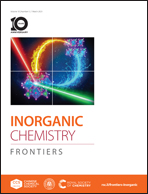A ratiometric fluorescent probe based on a dual-ligand lanthanide metal–organic framework (MOF) for sensitive detection of aluminium and fluoride ions in river and tap water†
Abstract
In this study, a ratiometric fluorescent probe towards Al3+ and F− using a lanthanide metal–organic framework material, Eu-BDC-NH2/TDA, is employed, which is composed of a metal centre Eu3+, BDC-NH2 and a TDA dual ligand. This three-dimensional frame structure selectively detects Al3+ and F− with a low limit of detection of 0.14 and 0.46 μM, respectively, accompanied by a naked-eye identification specificity in the range of 0–1000 μM. The detection mechanism of Eu-BDC-NH2/TDA towards Al3+ is due to the collapse of the framework and coordination interaction between Al3+ and the ligand, and that towards F− is due to a hydrogen-bond interaction, as evidenced by powder X-ray diffraction, Fourier-transform infrared spectroscopy, X-ray photoelectron spectroscopy and N2 adsorption–desorption analysis. Furthermore, practical application of Eu-BDC-NH2/TDA is successful for the detection of Al3+ and F− in river and tap water samples.

- This article is part of the themed collections: Inorganic Chemistry Frontiers Outstanding Paper Awards 2014-2023 and FOCUS: Design and applications of metal-organic frameworks (MOFs)


 Please wait while we load your content...
Please wait while we load your content...